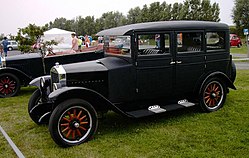Volvo ÖV 4
| Volvo ÖV 4 | |
|---|---|
 | |
| Overview | |
| Manufacturer | Volvo Personvagnar |
| Production |
|
| Designer | Jan G. Smith |
| Powertrain | |
| Engine | 1.9 L I4 |
| Transmission | 3-speed manual |
| Dimensions | |
| Wheelbase | 2,850 mm (112 in) |
| Curb weight | 1,170 kg (2,579 lb) |
| Chronology | |
| Successor | Volvo PV650 Series |



Volvo ÖV 4 is the first car built by Volvo. The designation ÖV 4 stands for "Öppen Vagn 4 cylindrar" in Swedish, which means Open Carriage 4 cylinders. The model ÖV 4 was often referred to as "Jakob" but that was just a name for one of the 10 pre-series ÖV 4 that was ready on 25 July, Jakob's name-day. All 10 prototypes were assembled in Stockholm at the company AB Galco, Hälsingegatan 41 where Gustav Larson worked at that time. Only one of the 10 pre-series cars manufactured during 1926 was saved for posterity and is housed at the Volvo Museum in Gothenburg, Sweden.
The engine was designed by Gustav Larson and its main chassis components by Jan G. Smith, a designer who had worked many years in the American automobile industry and returned to Sweden in 1924. Many of Jan G. Smith's original drawings for the ÖV4 and other technical papers[1] that he collected in America are saved in the archive of the National Museum of Science and Technology in Stockholm, Sweden.
When the first series produced ÖV4 was about to drive out of the factory and engineer Eric Carlberg put it into first gear, the car went backwards, where the car was actually in reverse gear. The explanation was that the differential gear in the rear axle had been fitted incorrectly. This mistake delayed the introduction by one day and the official introduction day for the ÖV4 was then adjusted to 14 April 1927, the day AB Volvo officially says the automobile company Volvo was "born"— this is from a marketing point of view. The company as an automobile company was born as a subsidiary company to SKF on 10 August 1926. The cabriolet was not very successful in the Swedish climate; the covered version, PV 4, was introduced in the end of 1928. Between 1927 and 1929 a total of 996 cars were manufactured.
Technical specification
- Engine: 4-cylinder side-valve, volume 1940 cc
- Power output: 28 hp (21 kW) @2000 rpm
- Max. output torque: 100 N⋅m (74 lb⋅ft)
- Gearbox: 3 forward, 1 reverse
- Max speed: recommended 60 km/h (37 miles/h), top speed 90 km/h (56 mph)
- Weight: 1,170 kg (2,579 lb)
References
- Volvo 1927-1977, red. Björn-Eric Lindh, Autohistorica, PR-Tryck, Sollentuna, 1977. ISSN 0345-1003
- Volvo Personvagnar-från 20-tal till 80-tal by Björn-Eric Lindh, 1984. (Swedish). ISBN 91-86442-06-6
- Volvo Owners Club, UK: The 30 year history of Volvo, by Assar Gabrielsson, 1959. (English).
Notes
- ^ The original drawings can be photographed at the National museum, referred to in this article.
External links
- Volvo Museum, Göteborg, Sweden. Official website.
- National Museum of Science and Technology, Stockholm, Sweden. Official website.
- Royal Swedish Academy of Engineering Sciences. Official website.
